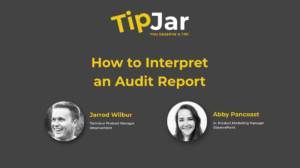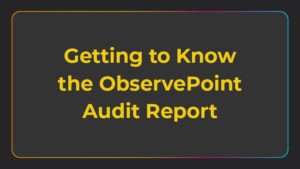![21 Point Google Analytics Audit [Checklist]](https://resources.observepoint.com/wp-content/uploads/21-Point-Google-Analytics-Audit-Checklist.webp)
Regardless of the size of your company, a periodic audit of your Google Analytics implementation is essential for verifying the accuracy of your data.
The 21 points explored in this Google Analytics audit guide are all designed to help you answer the most important question about your implementation: Can you trust your analytics data?
Special note about automation
As you go through the points in the post, keep in mind that automation will be your best friend.
Attempting to audit your implementation manually will prove to be difficult, as you will need to dedicate man-hours to combing through your website code and analytics tags in an effort to validate each bit of analytics tracking code. Additionally, websites are prone to change so the integrity of your analytics tracking can only be verified as far back as your last audit.
Where possible, automate your Google Analytics implementation audit with a tool like ObservePoint. As you go through the individual points of the below audit template, look for the ObservePoint logo to know which tasks you can automate with ObservePoint’s Technology Governance platform.
Conducting Your Audit [Template]
The points of this audit can be broken up into 4 categories, with some overlap:
- On-Page Audit
- Internal Data Quality Audit
- Conversion Measurement Audit
- Traffic Sources and Site Activity Review
Note that while most of these audit items apply to both Universal Analytics (GA3) and Google Analytics 4, a few will not apply for companies who exclusively use GA4.
On-Page Audit
An on-page audit involves going to your website and evaluating whether or not Google Analytics is correctly deployed and that no user experience issues inhibit your ability to collect meaningful data. The following 8 points address on-page audits.
1. Tag Presence
If tags are not present on an individual page, no data from that page can be collected. Any page interaction you want to track must have tags that are correctly installed and firing.
Ideally, 100% of a site’s pages will have Google Analytics tags and consistent tag versions deployed. You can verify tag presence manually page-by-page, or use ObservePoint’s Audits feature to scan a large batch of pages.
Keep in mind that your tags may be hard coded directly onto your site or fired via a tag management system like Google Tag Manager (GTM). If your tags are supposed to fire through GTM but aren’t, you may also need to conduct a Google Tag Manager audit.
ObservePoint’s Tag Inventory report can help you quickly identify which pages that both Google Analytics and Google Tag Manager are installed on (and, perhaps more importantly, which they are not installed on).
![21 Point Google Analytics Audit [Checklist]](https://resources.observepoint.com/wp-content/uploads/21-Point-Google-Analytics-Audit-Checklist1-1.png)
2. Duplicate Tags
Just like missing tags, duplicate tags can muddle your data quality because they risk inflating your metrics.
In the worst-case scenario, a single page view may be counted multiple times, causing the page to appear much more popular than it is.
Inflated pageviews can cause conversion rates to look lower than they are in reality. Ensure that you do not have duplicate analytics code deployed on the same page, and that if you do, all tags appear to be loading multiple requests in the manner you expect.
A common culprit for duplicate tags is having a Google Analytics event tag fire as a second page load tag from within Tag Manager.
ObservePoint’s Duplicates & Multiples Tags report can help you zero in on duplicate Google Analytics tags.
![21 Point Google Analytics Audit [Checklist]](https://resources.observepoint.com/wp-content/uploads/21-Point-Google-Analytics-Audit-Checklist2.png)
3. Vendor & Privacy Compliance
Google dictates that tags must be configured within a certain syntax and that certain disclosures are made on the website, like a valid privacy policy. When these standards are not kept, Google Analytics may truncate or discard data. You may also be in violation of data protection laws, depending on the location of the web visitor.
Compliance with data privacy policy has necessitated companies to adopt consent management platforms that enable users to define their preferences when it comes to analytics tracking and cookies. As part of your audit, you will need to verify that your tracking complies with your various consent profiles—authorized vs. non-authorized vs. partially authorized—so that you don’t violate important regulations like GDPR, CCPA, LGPD and others.
Testing your website’s privacy compliance under various consent states is both a high-risk and a highly error-prone activity. Automating the process is the safest way to maintain consistency in your testing.ObservePoint’s Privacy Compliance solution can help you:
- Inventory the tags and cookies on your site
- Test tag and cookie data against various consent profiles
- Confirm the geolocation of network request endpoints
- Detect and alert you of changes to JavaScript files
- Verify the presence of your privacy policy
4. Page and Tag Load Times
Auditing your page and tag load times is important because load times impact the performance of your site in several ways, causing issues like:
Limited Analytics Ability
If a page is slow to load and users navigate away from a page before the page has finished loading, Google Analytics may not execute, reducing the real visitor counts on those pages.
Inaccurate Data Comparison
Further inaccuracies with data collection can occur when different sections of your site load tags in different locations (such as at the top or bottom of the page), in which case a page loading dramatically faster or slower than another may cause unequal measurement in your reports.
User Experience Issues
Page load time is obviously an important part of user experience, and a slow-load time is a major contributing factor to page abandonment. The web tags on your pages impact how quickly, or slowly, they load.
Your audit needs to check against the possibility of data loss through long load times or inconsistent tag placement.
ObservePoint’s Tag Performance and Page Performance reports can give you a quick-and-easy view into which pages/tags are taking a long time to load.
![21 Point Google Analytics Audit [Checklist]](https://resources.observepoint.com/wp-content/uploads/21-Point-Google-Analytics-Audit-Checklist3-1.png)
5. Internal Linking
Redirects and broken links frustrate users and affect search engine rankings. Though not directly tied to your analytics solution, broken internal linking on your site can potentially drive away users and limit your pool of data.
Best practices dictate that no website should have page-not-found (400-series) errors and use redirects (300-series) only minimally. Ideally, all links should land on a regular page.
If your audit reveals a significant number of redirects, you should review your organization’s redirect policy, and remove as many internal redirect links as possible. You may need to update the internal site linking to point directly to the terminal page and eliminate the need to pass through a redirect.
ObservePoint’s Page Summary Status Codes report can reveal which pages on your site have unnecessary redirects or 400-series errors.
![21 Point Google Analytics Audit [Checklist]](https://resources.observepoint.com/wp-content/uploads/21-Point-Google-Analytics-Audit-Checklist4.png)
6. JavaScript Errors
If you have JavaScript errors within any of your on-page code, then Google Analytics may not fire, which means no data for you. The best practice is to keep errors at a minimum.
ObservePoint’s Browser Console Logs report reveals any and all errors, warnings, and other logs that showed up on each page during an audit.
![21 Point Google Analytics Audit [Checklist]](https://resources.observepoint.com/wp-content/uploads/21-Point-Google-Analytics-Audit-Checklist5.png)
7. Tag Validation
Tag validation refers to the process of verifying your analytics implementation (including tags, variables, events, the data layer, and other components) is collecting and transmitting the correct data to your Google Analytics solution.
Many analytics practitioners have some form of documentation like a tagging plan specifying how variables should be configured on each page. Tag validation verifies that your implementation matches the expectations outlined in your documentation. Specifically, tag validation with verify that:
- Google Analytics is firing as expected
- Google Analytics is tracking all appropriate variables (i.e. dimensions and metrics)
- The variable values are populated with data in the correct format (e.g. string vs. text vs. date)
Validating your implementation can be very tedious and prone to human error, in which case automation will be your best friend. ObservePoint’s Rules feature enables you to run tests against an audit to verify Google Analytics is tracking as intended.
8. Possible Data Leakage
As you audit for Google Analytics data collection, you will likely uncover additional, unauthorized tracking technologies on your site. If an unauthorized technology is sending sensitive data to third parties or to an unauthorized location, that’s a red flag you need to address immediately.
ObservePoint’s Privacy Compliance can help you identify unauthorized tags, cookies, and server locations. In addition, the Tag Initiators report can help you identify how unauthorized tags arrive on your site (often through piggybacking).
![21 Point Google Analytics Audit [Checklist]](https://resources.observepoint.com/wp-content/uploads/21-Point-Google-Analytics-Audit-Checklist6.png)
Internal Data Quality Audit
This phase of your audit is a check-up on the internal configurations within Google Analytics that can affect the quality of your data. The following 4 points are specific settings you should evaluate in Google Analytics.
9. Internal Traffic (IP Address) Exclusion
Certain visitors who don’t accurately reflect your target audience, like company employees, may frequent your site and artificially inflate visit and page view counts. Google Analytics allows you to filter out these users by IP address (range).
During your audit, you should review the configured filters to ensure you are excluding appropriate traffic happening in the office.
What about traffic from remote employees accessing the website from home? Google doesn’t have a built-in way to easily filter out this traffic, considering that the IP addresses of home networks are dynamic and because gathering IP addresses of hundreds of employees is untenable.
One solution is to set up a script on your site that sets a cookie indicating internal traffic based on a URL query parameter (e.g. /?internal_traffic=true), then adjusting your Google Tag Manager triggers to only fire if the “internal traffic” cookie is not present.
Once you’ve implemented a solution for internal traffic exclusion, you can use an ObservePoint audit combined with the Rules feature to verify that ObservePoint doesn’t fire for internal traffic.
10. External Data Sources Enabled
Google Analytics has access to a wealth of data from some of Google’s other marketing technologies. Many of these tools allow you to pull this data directly into Google Analytics.
For example, you can pull in data from Google AdWords for valuable information about how much of your website traffic or sales are driven by AdWords.
Information informs insights, which inform decisions, so do your research about what other data you can pull into Google Analytics.
11. Page Naming
Relevant and accurate page names are critical to the organic search success of your website. Page names also serve as the title text when a visitor bookmarks your site. Ensure that all the pages you audit have a page title.
Sometimes it is common practice for pages to share identical titles, but to make sure your site is more thoroughly optimized, we recommend you update the title tags on each page to provide a unique name to each relevant URL.
12. Internal Search
Setting up internal search in Google Analytics allows you to evaluate where visitors search, what they search for, and the quality of the provided search results. Understanding the effectiveness of your internal search is important because visitors who perform internal searches convert at a substantially higher rate.
Conversion Tracking Audit
Mature Google Analytics implementations measure conversion events to see if website visitors are successfully completing desired actions. Unlike page view tracking, event tags only fire when a specific event occurs. As part of your audit, you will want to verify that conversion tracking is firing as expected.
13. Conversion Events
Begin your audit by understanding and labeling the conversion events your website has. Your conversion events will likely have custom dimensions and metrics associated with them, so you will want to make sure that when Google Analytics logs a conversion event, the tracking includes those custom definitions.
Ultimately, your audit will require you to simulate those events and verify the corresponding request to the Google Analytics server contains the appropriate data. You can approach this process manually or via automation with ObservePoint’s Audits and Journeys features.
During a scan of your site, ObservePoint can simulate user actions like form fills, selects, clicks, and submits, while also validating the analytics requests being sent off as a result of these actions.
14. eCommerce Tracking
Through eCommerce tracking, your organization can evaluate the effectiveness of marketing investments and site optimizations.
You will validate your eCommerce tracking the same way you do other conversion events, with a focus on the unique data points sent in an eCommerce event request.
You can also gauge the accuracy of your eCommerce data by comparing it against your company’s ordering system data.
Using Audits, Journeys, and Rules in tandem, ObservePoint users can verify that Google Analytics is capturing and transmitting eCommerce variables correctly.
15. Campaign Tracking
Campaign attribution made possible by URL query parameters is one of the primary goals of web analytics, particularly for eCommerce companies. Auditing your campaign tracking is perhaps the single most important part of a comprehensive audit.
Campaign tracking errors can occur as a result of one or both of the following misconfigurations:
- Campaign tracking codes (URL query parameters) are formatted incorrectly
2. Google Analytics tags on the campaign landing page don’t correctly capture the campaign parameters
During your Google Analytics audit you should review both of the above campaign tracking components to ensure that your marketing efforts are receiving proper attribution.
Traffic Sources and Site Activity Review
This portion of your audit is an evaluation of some of the most important traffic sources, paths, and pages on your site. As you build out a repeatable auditing process (ideally through automation), the below assets will be the most important for you to audit to verify accurate data collection.
16. Best Performing Traffic Sources
One of the key benefits of using Google Analytics in online marketing is being able to compare the effectiveness of traffic sources. You can evaluate how much of your traffic comes from Google/organic search, direct site access, AdWords, Bing/organic and email campaigns, among others.
17. Best Performing Keywords
Understanding how organic search visitors are finding your website is an important part of evaluating marketing efforts.
Within Google Analytics, you used to have a report showing how specific keywords were bringing in traffic. However, for privacy reasons, this report is limited as Google now hides the search keywords of web visitors who were logged in to their Google account.
While directly recreating this report isn’t possible, there are alternatives available, such as Google Search Console.
18. Critical Visitor and Conversion Paths
Understanding how visitors use your website is an important element in optimizing the site. During your audit, consider which pages users most often access after coming to your home page. Are these the pages you expect? What insight does this reveal about user behavior?
If your site has a high-traffic conversion path, such as a booking path, you will want to make sure each page and component in that booking path is consistently available to users.
ObservePoint’s Journeys feature can simulate user traffic, moving through these conversion paths on a set schedule (e.g. every 15 minutes) to make sure they are functioning properly.
19. Top Ten Pages
Identify which pages on your site consistently have the most traffic. Doing so will help you prioritize future auditing efforts. Make sure Google Analytics is properly installed on these top pages, either through a manual on-page audit or via automation.
An ObservePoint Audit can scan your top pages on a set schedule (e.g., every hour, every day, etc.) to verify that Google Analytics is properly installed on each page.
An important tracking limitation to consider is whether the influx of traffic recorded on these pages will exceed your account’s data collection limit. According to Google, if you exceed the limit, “there is no assurance the excess hits will be processed.” Google provides some recommendations on what to do if you currently are exceeding the data collection limits.
20. Landing Pages Review
To ensure marketing spends are being used effectively, you need to optimize your landing pages. As part of your audit, look at the highest trafficked landing pages and verify whether they meet your expectations. If a landing page is over or underperforming your expectations, conduct an on-page audit manually or via automation to verify that Google Analytics is installed correctly on that page.
An ObservePoint Audit can scan your landing pages at regular intervals or during planned campaign activity to ensure they are available and tracking correctly.
21. Worst Performing Pages
Taking a moment to consider which pages have the lowest performance can help you understand if visitors appear to be using your site as designed, as well as help you eliminate clutter if the pages are no longer relevant.
Sometimes pages that look like they’re not performing well may just have broken analytics tracking. Periodically check your worst pages to make sure analytics tracking is working properly.
Scheduled audits of your site with ObservePoint can help you catch tracking errors early so you can minimize data loss.
Expedite and Automate Your Audit with ObservePoint
Clearly, a thorough Google Analytics audit is a significant undertaking, and one with a short shelf life at that. Remember, you can trust the quality of your data only as far back as validated by your last audit.
The problem is that for most enterprise websites, a page-by-page audit is nearly impossible to execute manually, which is why automation is so important. Ongoing, automated audits help restore trust in your data quality and can reduce the burden on the teams responsible for verifying the accuracy of their analytics implementation.
ObservePoint’s automated tag governance and analytics testing solution can help. Schedule a complimentary Google Analytics Audit to see ObservePoint in action.





